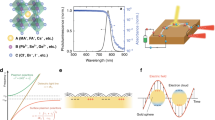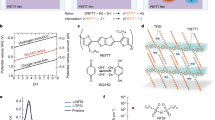Abstract
To develop electronic devices with novel functionalities and applications1,2, various non-silicon-based materials are currently being explored3,4,5. Nanoparticles have unique characteristics due to their small size, which can impart functions that are distinct from those of their bulk counterparts6. The use of semiconductor nanoparticles has already led to improvements in the efficiency of solar cells7, the processability of transistors8 and the sensitivity of photodetectors9, and the optical and catalytic properties of metal nanoparticles have led to similar advances in plasmonics10 and energy conversion11. However, metals screen electric fields and this has, so far, prevented their use in the design of all-metal nanoparticle circuitry12,13,14,15. Here, we show that simple electronic circuits can be made exclusively from metal nanoparticles functionalized with charged organic ligands. In these materials, electronic currents are controlled by the ionic gradients of mobile counterions surrounding the ‘jammed’ nanoparticles. The nanoparticle-based electronic elements of the circuitry can be interfaced with metal nanoparticles capable of sensing various environmental changes (humidity, gas, the presence of various cations), creating electronic devices in which metal nanoparticles sense, process and ultimately report chemical signals. Because the constituent nanoparticles combine electronic and chemical sensing functions, we term these systems ‘chemoelectronic’. The circuits have switching times comparable to those of polymer electronics, selectively transduce parts-per-trillion chemical changes into electrical signals, perform logic operations, consume little power (on the scale of microwatts), and are mechanically flexible. They are also ‘green’, in the sense that they comprise non-toxic nanoparticles cast at room temperature from alcohol solutions.
This is a preview of subscription content, access via your institution
Access options
Subscribe to this journal
Receive 12 print issues and online access
$259.00 per year
only $21.58 per issue
Buy this article
- Purchase on Springer Link
- Instant access to full article PDF
Prices may be subject to local taxes which are calculated during checkout




Similar content being viewed by others
References
He, J., Nuzzo, R. G. & Rogers, J. A. Inorganic materials and assembly techniques for flexible and stretchable electronics. Proc. IEEE 103, 619–632 (2015).
Liu, J. et al. Syringe-injectable electronics. Nature Nanotech. 10, 629–636 (2015).
Fiori, G. et al. Electronics based on two-dimensional materials. Nature Nanotech. 9, 768–779 (2014).
Wang, C., Dong, H., Hu, W., Liu, Y. & Zhu, D. Semiconducting π-conjugated systems in field-effect transistors: a material odyssey of organic electronics. Chem. Rev. 112, 2208–2267 (2011).
Song, H., Reed, M. A. & Lee, T. Single molecule electronic devices. Adv. Mater. 23, 1583–1608 (2011).
Talapin, D. V., Lee, J.-S., Kovalenko, M. V. & Shevchenko, E. V. Prospects of colloidal nanocrystals for electronic and optoelectronic applications. Chem. Rev. 110, 389–458 (2010).
Ellingson, R. J. et al. Highly efficient multiple exciton generation in colloidal PbSe and PbS quantum dots. Nano Lett. 5, 865–871 (2005).
Lee, J.-S., Kovalenko, M. V., Huang, J., Chung, D. S. & Talapin, D. V. Band-like transport, high electron mobility and high photoconductivity in all-inorganic nanocrystal arrays. Nature Nanotech. 6, 348–352 (2011).
Konstantatos, G. et al. Ultrasensitive solution-cast quantum dot photodetectors. Nature 442, 180–183 (2006).
Sheldon, M. T., Van de Groep, J., Brown, A. M., Polman, A. & Atwater, H. A. Plasmoelectric potentials in metal nanostructures. Science 346, 828–831 (2014).
Huang, X. et al. High-performance transition metal-doped Pt3Ni octahedra for oxygen reduction reaction. Science 348, 1230–1234 (2015).
Moreira, H. et al. Electron cotunneling transport in gold nanocrystal arrays. Phys. Rev. Lett. 107, 176803 (2011).
Wessels, J. M. et al. Optical and electrical properties of three-dimensional interlinked gold nanoparticle assemblies. J. Am. Chem. Soc. 126, 3349–3356 (2004).
Kim, Y. et al. Stretchable nanoparticle conductors with self-organized conductive pathways. Nature 500, 59–63 (2013).
Zabet-Khosousi, A. & Dhirani, A. Charge transport in nanoparticle assemblies. Chem. Rev. 108, 4072–4124 (2008).
Jana, N. R. & Peng, X. Single-phase and gram-scale routes toward nearly monodisperse Au and other noble metal nanocrystals. J. Am. Chem. Soc. 125, 14280–14281 (2003).
Witt, D., Klajn, R., Barski, P. & Grzybowski, B. A. Applications, properties and synthesis of ω-functionalized n-alkanethiols and disulfides—the building blocks of self-assembled monolayers. Curr. Org. Chem. 8, 1763–1797 (2004).
Akinoglu, E. M. et al. Evidence for critical scaling of plasmonic modes at the percolation threshold in metallic nanostructures. Appl. Phys. Lett. 103, 171106 (2013).
Giersig, M. & Mulvaney, P. Preparation of ordered colloid monolayers by electrophoretic deposition. Langmuir 9, 3408–3413 (1993).
Kalsin, A. M., Kowalczyk, B., Smoukov, S. K., Klajn, R. & Grzybowski, B. A. Ionic-like behavior of oppositely charged nanoparticles. J. Am. Chem. Soc. 128, 15046–15047 (2006).
Nakanishi, H. et al. Dynamic internal gradients control and direct electric currents within nanostructured materials. Nature Nanotech. 6, 740–746 (2011).
Cho, E. S. et al. Ultrasensitive detection of toxic cations through changes in the tunnelling current across films of striped nanoparticles. Nature Mater. 11, 978–985 (2012).
Fowler, R. H. & Nordheim, L. Electron emission in intense electric fields. Proc. R. Soc. Lond. A 119, 173–181 (1928).
Isaacs, N. S. Physical Organic Chemistry (Longman Scientific & Technical, 1995).
Onsager, L. Initial recombination of ions. Phys. Rev. 54, 554–557 (1938).
Buck, R. P. & Lindner, E. Recommendations for nomenclature of ion selective electrodes (IUPAC Recommendations 1994). Pure Appl. Chem. 66, 2527–2536 (1994).
Walker, D. A., Kowalczyk, B., de la Cruz, M. O. & Grzybowski, B. A. Electrostatics at the nanoscale. Nanoscale 3, 1316–1344 (2011).
Sillén, L. G., Martell, A. E. & Bjerrum, J. Stability Constants of Metal–Ion Complexes (Chemical Society London, 1964).
Martinez, A. W., Phillips, S. T., Whitesides, G. M. & Carrilho, E. Diagnostics for the developing world: microfluidic paper-based analytical devices. Anal. Chem. 82, 3–10 (2009).
Lide, D. R. CRC Handbook of Chemistry and Physics (CRC, 2004).
Acknowledgements
The work was partly supported by the Non-Equilibrium Energy Research Center (NERC), which is an Energy Frontier Research Center funded by the US Department of Energy, Office of Science, Office of Basic Energy Sciences under award DE-SC0000989. Y.Y. acknowledges support from the Chinese Academy of Sciences and the National Natural Science Foundation of China (21571039). B.A.G. acknowledges support from the Institute for Basic Science Korea, Project Code IBS-R020-D1. The authors thank Q. Zhuang for assistance with 2 nm nanoparticle synthesis. The authors also thank K.S. Kim and R. Hołyst for help in modelling the counterion entropy of mixing.
Author information
Authors and Affiliations
Contributions
Y.Y. carried out the experiments and, with S.C.W., performed data analysis. P.F. modelled the experimental results. Y.Y., S.C.W. and B.A.G. wrote the manuscript. B.A.G. conceived and supervised the project.
Corresponding author
Ethics declarations
Competing interests
The authors declare no competing financial interests.
Supplementary information
Supplementary information
Supplementary information (PDF 2253 kb)
Rights and permissions
About this article
Cite this article
Yan, Y., Warren, S., Fuller, P. et al. Chemoelectronic circuits based on metal nanoparticles. Nature Nanotech 11, 603–608 (2016). https://doi.org/10.1038/nnano.2016.39
Received:
Accepted:
Published:
Issue Date:
DOI: https://doi.org/10.1038/nnano.2016.39
This article is cited by
-
CO2 Laser Sintering of TiO2 Nanoparticles Thin Films for Improved Transmittance
Lasers in Manufacturing and Materials Processing (2024)
-
A nanogenerator based on metal nanoparticles and magnetic ionic gradients
NPG Asia Materials (2023)
-
Iontronic components: From liquid- to solid-states
Nano Research (2023)
-
Anomalous refinement and uniformization of grains in metallic thin films
Nano Research (2023)
-
Transistors and logic circuits based on metal nanoparticles and ionic gradients
Nature Electronics (2021)



